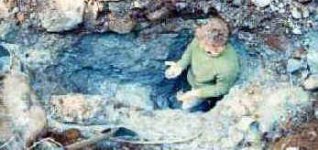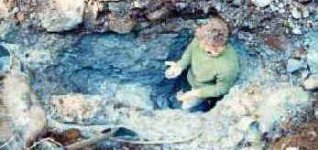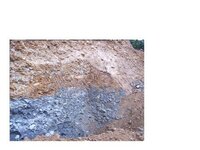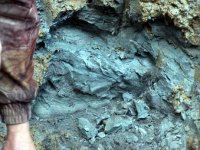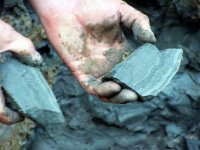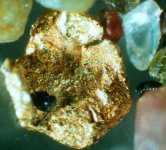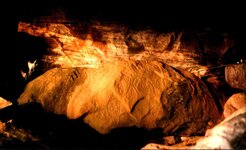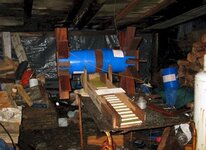You are using an out of date browser. It may not display this or other websites correctly.
You should upgrade or use an alternative browser.
You should upgrade or use an alternative browser.
BLUE CLAY
- Thread starter hmmm
- Start date
hmmm
Hero Member
- Jun 9, 2007
- 830
- 95
- Primary Interest:
- All Treasure Hunting
- Thread starter
- #101
Rare earths 
this assay shows some rare earth minerals and check out the ba.
http://bluestoneclay.webs.com/assaymi.jpg
http://bluestoneclay.webs.com/asseymich1.jpg

this assay shows some rare earth minerals and check out the ba.
http://bluestoneclay.webs.com/assaymi.jpg
http://bluestoneclay.webs.com/asseymich1.jpg
hmmm
You mentioned in the early parts of this thread that you planned to "tightline buckets down the hill". If I'm not mistaken, I'd say you've spent some time high lead logging on the sidehills of Vancouver Island to be using that kind of terminology. I'm north of you on the Queen Charlotte Islands and put 30 years in working in the Bush here; mostly on steelspars, slacklines and grapple yarders.
Anyways, there are things that may help your clay problem a bit. I'm referring to "flocculants" and "deflocculants".
A flocculant is a polymer compound that, when added to murky clay-ridden water, will cause all of the micron clay particles to join together and drop out of the water; leaving it clear.
A deflocculant, on the other hand, will cause lumps of clay to disperse back into those same micron particles. This will effectively break your clay up into a liquid and facilitate PM removal. Examples of deflocculants include sodium carbonate (washing soda or soda ash), sodium and potassium hydroxides, sodium silicate, phosphates and polyphosphates and sodium and ammonium oxalates.
Sodium silicate seems to be the most effective, cheapest and readily available deflocculant. A little bit added to a tub full of clay and water is said to turn lumps of clay to soup in seconds.
Bob
You mentioned in the early parts of this thread that you planned to "tightline buckets down the hill". If I'm not mistaken, I'd say you've spent some time high lead logging on the sidehills of Vancouver Island to be using that kind of terminology. I'm north of you on the Queen Charlotte Islands and put 30 years in working in the Bush here; mostly on steelspars, slacklines and grapple yarders.
Anyways, there are things that may help your clay problem a bit. I'm referring to "flocculants" and "deflocculants".
A flocculant is a polymer compound that, when added to murky clay-ridden water, will cause all of the micron clay particles to join together and drop out of the water; leaving it clear.
A deflocculant, on the other hand, will cause lumps of clay to disperse back into those same micron particles. This will effectively break your clay up into a liquid and facilitate PM removal. Examples of deflocculants include sodium carbonate (washing soda or soda ash), sodium and potassium hydroxides, sodium silicate, phosphates and polyphosphates and sodium and ammonium oxalates.
Sodium silicate seems to be the most effective, cheapest and readily available deflocculant. A little bit added to a tub full of clay and water is said to turn lumps of clay to soup in seconds.
Bob
tapoutking
Sr. Member
Wow!!! Just wow!
Not every deflocculant will work with your particular breed of clay. Sometimes, a combination of different deflocculants is required. Using too much deflocculant must be avoided, as well. There is a minimum viscosity that can be reached at the point of maximum deflocculation; going beyond this point, by adding more deflocculant, will cause the viscosity to go back up.
The deflocculants I mentioned are only some of the common inorganic ones. There are many organic ones, as well.
For hard pack clays, a cement mixer would be greatly beneficial. Its breaking action, combined with the deflocculant making each clay particle repel all of the others, should be all that you need. Just remember, any water introduced later to the deflocculated clay (ie. during panning, sluicing, screening, etc.) that does not contain some deflocculant may reverse the deflocculation state by diluting the deflocculants in your clay and water mixture.
Regards
Bob
The deflocculants I mentioned are only some of the common inorganic ones. There are many organic ones, as well.
For hard pack clays, a cement mixer would be greatly beneficial. Its breaking action, combined with the deflocculant making each clay particle repel all of the others, should be all that you need. Just remember, any water introduced later to the deflocculated clay (ie. during panning, sluicing, screening, etc.) that does not contain some deflocculant may reverse the deflocculation state by diluting the deflocculants in your clay and water mixture.
Regards
Bob
FiresEye
Sr. Member
- Aug 17, 2010
- 322
- 5
Yeah that's a good point, and clay takes a lot of water or a lot of ingenuity( aka deffloculant knowledge) to work through it, but it can be worth it. I like the idea about a cement mixer.. I use a sturdy 5 gallon bucket with a wooden rod to crush the clays while in the river to wash out the lighter clays. once broken down a bit I classify it and then crush more if needed. Around my part's there's light tan, deep red, black, and orange clays, all of them hard as a brick, some of them with gold.
Astrobouncer
Hero Member
- Jun 21, 2009
- 823
- 343
I found some of that blue clay here in South Carolina, and sure enough, it has plenty of fine gold. There's also a black gummy type rock that is in abundance with the clay, as well as lots of white quartz, some of which is pock marked.
Here's a bad picture of the blue clay, you can see it better in the video below.

Here's the short video. The blue clay is under an old bench deposit. It has enough gold to keep me digging there once it warms up.
http://img293.imageshack.us/img293/4688/vcx.mp4
Its a little hard to make out the blue color, but there's no mistaking it in person.
Here's a bad picture of the blue clay, you can see it better in the video below.

Here's the short video. The blue clay is under an old bench deposit. It has enough gold to keep me digging there once it warms up.
http://img293.imageshack.us/img293/4688/vcx.mp4
Its a little hard to make out the blue color, but there's no mistaking it in person.
Klondikeike
Full Member
- Aug 13, 2010
- 247
- 36
- Detector(s) used
- H3 element detector, JeoHunter Dual 3-D Imaging Detector
- Primary Interest:
- All Treasure Hunting
Hello Hmmmmm...
Here is a picture of an actual part of the "old Blue lead"... This was part of our mine in Oregon... There is an absence of much clay, it is truly a real river channel, but everything is as blue as you see it in the pic...and it was RICH... no nuggets...just lots and lots of fine small gold...and not real pure.. in the high 70's...and thin and very, very difficult to capture... once we dug at the end of an old "long tom" from a 100 years ago... the amount of gold we recovered in this small area was incredible... the old timers were not aware of how much they were loosing over the end of the their old wood riffle boxes....
This is what the Blue Lead Looks like....
Klondike...
Here is a picture of an actual part of the "old Blue lead"... This was part of our mine in Oregon... There is an absence of much clay, it is truly a real river channel, but everything is as blue as you see it in the pic...and it was RICH... no nuggets...just lots and lots of fine small gold...and not real pure.. in the high 70's...and thin and very, very difficult to capture... once we dug at the end of an old "long tom" from a 100 years ago... the amount of gold we recovered in this small area was incredible... the old timers were not aware of how much they were loosing over the end of the their old wood riffle boxes....
This is what the Blue Lead Looks like....
Klondike...
Attachments
hmmm
Hero Member
- Jun 9, 2007
- 830
- 95
- Primary Interest:
- All Treasure Hunting
- Thread starter
- #110
HI BOB
i have been using a cement mixer to break the clay, then letting the clay settel. i like the seperation method you speak of but not sure if it is a good idea for cosmetic clay.
hellow klondike
i am very interisted in learning more about the "old blue lead" . you say you mined it in oregon, any chance you will show me where it is, which way it runs, i have a theory my creek is part of the old blue lead, if not the start of it. pangea? i have two spots with the blue lead, 1 spot is a creek bed the other is very odd, it is a mound on the steep side of the mountain, i would like to start to mine this in the spring , any advise would be greatly apreciated.
i am on south vancouver island so oregon is not far from me.
merry christmass
in the picture you can see what we have been selling as healing clay, we have been digging out the slab of nearly pure blue clay that caps the blue lead. un fortunitly its not as easy to sell as it would be to sell gold.
i have been using a cement mixer to break the clay, then letting the clay settel. i like the seperation method you speak of but not sure if it is a good idea for cosmetic clay.
hellow klondike
i am very interisted in learning more about the "old blue lead" . you say you mined it in oregon, any chance you will show me where it is, which way it runs, i have a theory my creek is part of the old blue lead, if not the start of it. pangea? i have two spots with the blue lead, 1 spot is a creek bed the other is very odd, it is a mound on the steep side of the mountain, i would like to start to mine this in the spring , any advise would be greatly apreciated.
i am on south vancouver island so oregon is not far from me.
merry christmass
in the picture you can see what we have been selling as healing clay, we have been digging out the slab of nearly pure blue clay that caps the blue lead. un fortunitly its not as easy to sell as it would be to sell gold.
Attachments
Klondikeike
Full Member
- Aug 13, 2010
- 247
- 36
- Detector(s) used
- H3 element detector, JeoHunter Dual 3-D Imaging Detector
- Primary Interest:
- All Treasure Hunting
Long time ago, before the major up lift of the west coast plates...and the creation of the Sierra Nevada Mountains, and before the rivers started to run east and west in what is now California, the rivers ran mostly north to south... one of those rivers had a blue color to the sand, blue stained rocks and was usually very rich in gold.... Pieces of this river were found in the deserts of California, the northern mountains of California and Oregon... No one knows for sure the actual route the river ran, but it is usually and generally accepted it ran from somewhere in Canada to Mexico and near the present day Sierra Mountains... But who knows, you might find a piece of it anywhere.... as far as anyone knows, it isn't intact and is only found in bits and pieces of a once roaring river..
I've seen pieces of it near Barstow, Cal in the late 1960's... and what I mined on in Oregon... other than that, I haven't personally seen any other parts of the "Blue lead"...
I hope you do have a small part of it, because if you do, you'll probably find it very, very rich indeed...
Good luck to you... what you have is a very pretty blue color, for sure...
Klondike
I've seen pieces of it near Barstow, Cal in the late 1960's... and what I mined on in Oregon... other than that, I haven't personally seen any other parts of the "Blue lead"...
I hope you do have a small part of it, because if you do, you'll probably find it very, very rich indeed...
Good luck to you... what you have is a very pretty blue color, for sure...
Klondike
hmmm
Hero Member
- Jun 9, 2007
- 830
- 95
- Primary Interest:
- All Treasure Hunting
- Thread starter
- #112
 Klondike
KlondikeTHAT IS VERY ITERISTING
my blue lead stream bed is uique,. it runs due south, it starts near the top of a volcaic crator, just in the troat where a sheer also runs north / south. the blue ground runs for about 2 km then it just dissapears, it looks like the end of a old mine. this is where it gets interistsing, the empty streambed flows for 2 more km then drops into the sea. it has beec cut off as is the land was cut in half. the fine gold FROM THE BEDROCK EXPOSED BELOW THE END OF THE BLUE HARD PANN is very unique. very rough edged.
Attachments
hmmm
Hero Member
- Jun 9, 2007
- 830
- 95
- Primary Interest:
- All Treasure Hunting
- Thread starter
- #113

Here is somthin interesting, i mentioned the creek flows from a volcano. it is a huge very old volcano that had exploded into 7 peices.

in 1946 canada experienced a huge earth quake with the epicenteron the island. old timers said the volcanio blew steam out of a vent that is on the dike that runs through the blue caly, they claim it also spued salamoniac gas from another vent.
on a diferent note, there is a old smelter dug out of the sand stone at the base of the creek. hmmmm
Attachments
Klondikeike
Full Member
- Aug 13, 2010
- 247
- 36
- Detector(s) used
- H3 element detector, JeoHunter Dual 3-D Imaging Detector
- Primary Interest:
- All Treasure Hunting
Hey Hmmmmm...
There are several different types of river channels... In the Sierra's of California... we have PRIMARY and 1st SECONDARY, and 2nd SECONDARY and 3RD SECONDARY and so on..as successive rivers broke out the their valley and started a new channel...
Almost exclusively, the PRIMARY channels are void of volcanic dust or ash/clay... the 1st SECONDARY was created by the injection of volcanic runs that covered the PRIMARY up and forced the river out of its banks into a new channel.. and this channel will have lots and lots of volcanic clay in the gravels...so much so, it can be difficult to separate the gold from the clays...Each successive SECONDARY river became less and less rich...with the exception of the 1st SECONDARY.. it usually has its own gold source, plus it picked up gold from the primary at the rim breakout...
Not all primaries are blue.. one one special primary river was blue...The Blue Lead...
The Blue Lead usually does NOT have any volcanic clay in it...
Near Downieville, California... I mined a primary and 7 Secondaries....Where the break out of all these channels began, is now in mid air as the canyon below in now the main river course.. that river course is the Downie River.... Just up stream from the confluence of the Downie River and the North Fork of the Yuba.. is a place history calls the "Blue Banks"... it was so incredibly rich... from all 8 rivers, 1 primary and 7 secondaries creating the Downie canyon... and the gold stopped here...at the Blue Banks... Major Downie, in the mid 800's..on his 3rd trip to Downieville, thought the area was mined out because when he slid his boot over and through the sand bars of the river, he could no longer see gold nuggets and flakes in the sand...
That's the kind of richness the Blue Lead is...
Hope you do have a piece of the 'ol Blue Lead...
Klondike...
There are several different types of river channels... In the Sierra's of California... we have PRIMARY and 1st SECONDARY, and 2nd SECONDARY and 3RD SECONDARY and so on..as successive rivers broke out the their valley and started a new channel...
Almost exclusively, the PRIMARY channels are void of volcanic dust or ash/clay... the 1st SECONDARY was created by the injection of volcanic runs that covered the PRIMARY up and forced the river out of its banks into a new channel.. and this channel will have lots and lots of volcanic clay in the gravels...so much so, it can be difficult to separate the gold from the clays...Each successive SECONDARY river became less and less rich...with the exception of the 1st SECONDARY.. it usually has its own gold source, plus it picked up gold from the primary at the rim breakout...
Not all primaries are blue.. one one special primary river was blue...The Blue Lead...
The Blue Lead usually does NOT have any volcanic clay in it...
Near Downieville, California... I mined a primary and 7 Secondaries....Where the break out of all these channels began, is now in mid air as the canyon below in now the main river course.. that river course is the Downie River.... Just up stream from the confluence of the Downie River and the North Fork of the Yuba.. is a place history calls the "Blue Banks"... it was so incredibly rich... from all 8 rivers, 1 primary and 7 secondaries creating the Downie canyon... and the gold stopped here...at the Blue Banks... Major Downie, in the mid 800's..on his 3rd trip to Downieville, thought the area was mined out because when he slid his boot over and through the sand bars of the river, he could no longer see gold nuggets and flakes in the sand...
That's the kind of richness the Blue Lead is...
Hope you do have a piece of the 'ol Blue Lead...
Klondike...
dave wiseman
Hero Member
Southern Yankee
Greenie
- Jul 10, 2010
- 19
- 0
Ok, I have an Idea. I'm pretty new at this so please go easy one me if this has been tried or if it's too expensive to be possible. What is you fire the clay to dry it out. Then crush it and and run it through a sluice. I know that clay, when fired, becomes like stone and I would think it could be treated as such. Just an idea.....what do you guys think?
tapoutking
Sr. Member
Southern Yankee said:Ok, I have an Idea. I'm pretty new at this so please go easy one me if this has been tried or if it's too expensive to be possible. What is you fire the clay to dry it out. Then crush it and and run it through a sluice. I know that clay, when fired, becomes like stone and I would think it could be treated as such. Just an idea.....what do you guys think?
*DING DING That sounds reasonable!
hmmm
Hero Member
- Jun 9, 2007
- 830
- 95
- Primary Interest:
- All Treasure Hunting
- Thread starter
- #118
ding ding that works better then you think, if you dry the clay, then put water to it , the clay dizzolvs. just cant fire it to hot.Southern Yankee said:Ok, I have an Idea. I'm pretty new at this so please go easy one me if this has been tried or if it's too expensive to be possible. What is you fire the clay to dry it out. Then crush it and and run it through a sluice. I know that clay, when fired, becomes like stone and I would think it could be treated as such. Just an idea.....what do you guys think?
a tromel will breakk up the clay dry or wet, all i need is a real tromel.
Attachments
Tuberale
Gold Member
It would help to know where you're at.hmmm said:HI ALL
can any one enlighten me on blue clay, i have found a small gully, when i pann the blue clay i get lots of black sand.
However, if you are in CA, you may have hit it big time.
Blue clay on river terraces high above current rivers are often the sources for alluvial gold. Geologically the formation is sometimes called the "Big Blue", a reverence to an ancient river channel which flowed mostly north and south, and may well have been from the Columbia River further north.
Some of the largest gold nuggets, as well as quite a few diamonds have come from blue clay deposits in the Big Blue.
Southern Yankee
Greenie
- Jul 10, 2010
- 19
- 0
ding ding that works better then you think, if you dry the clay, then put water to it , the clay dizzolvs. just cant fire it to hot.
a tromel will breakk up the clay dry or wet, all i need is a real tromel.
[/quote]
What I was saying is to fire it like you were trying to make a brick out of it. Get it as hard as you could, then put it in a ball mill and crush it into a very fine powder. You could then treat it just like you would any other rock. That is what I was getting at.
a tromel will breakk up the clay dry or wet, all i need is a real tromel.
[/quote]
What I was saying is to fire it like you were trying to make a brick out of it. Get it as hard as you could, then put it in a ball mill and crush it into a very fine powder. You could then treat it just like you would any other rock. That is what I was getting at.
Top Member Reactions
-
 2585
2585 -
 1137
1137 -
 1063
1063 -
 903
903 -
 882
882 -
 847
847 -
 806
806 -
 694
694 -
 638
638 -
 552
552 -
 488
488 -
 479
479 -
 478
478 -
 464
464 -
 461
461 -
O
435
-
 430
430 -
 391
391 -
 380
380 -
 365
365
Users who are viewing this thread
Total: 2 (members: 0, guests: 2)


